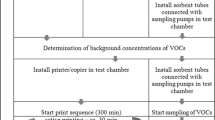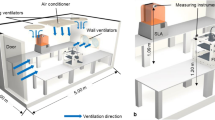Abstract
3D printing has been gaining popularity in the past few years for both personal and professional uses. However, recent results showed that desktop 3D printers emit particles and compounds, which have negative health effects. In this study, the emission from commercially available 3D printing polymers was evaluated. Volatile organic compounds (VOC) emission was studied by using commercial printer placed in gas tight chamber, but also in a very universal test, which simulates the condition in fused filament fabrication 3D printers and in the same time allows for comparison of various filaments without the impact of the 3D printer itself (ex vivo approach). VOC emission can be associated with thermal degradation of polymers as well as degradation of additives such as plasticizers, dyes or flame retardants, as confirmed by detailed FTIR analysis of filaments. The obtained results highlight the problem of emissions of harmful compounds, and the proposed testing methods can be a clue for plastic filament producers on how to test their products and make them safer.
Graphic abstract











Similar content being viewed by others

References
Achilli E, Minguzzi A, Visibile A et al (2016) 3D-printed photo-spectroelectrochemical devices for in situ and in operando X-ray absorption spectroscopy investigation. J Synchrotron Radiat 23:622–628. https://doi.org/10.1107/S1600577515024480
Afshar-Mohajer N, Wu C-Y, Ladun T et al (2015) Characterization of particulate matters and total VOC emissions from a binder jetting 3D printer. Build Environ 93:293–301. https://doi.org/10.1016/j.buildenv.2015.07.013
An J, Kim C, Choi B-H, Lee J-M (2014) Characterization of acrylonitrile–butadiene–styrene (ABS) copolymer blends with foreign polymers using fracture mechanism maps. Polym Eng Sci 54:2791–2798. https://doi.org/10.1002/pen.23836
Azimi P, Zhao D, Pouzet C et al (2016) Emissions of ultrafine particles and volatile organic compounds from commercially available desktop three-dimensional printers with multiple filaments. Environ Sci Technol 50:1260–1268. https://doi.org/10.1021/acs.est.5b04983
Azimi P, Fazli T, Stephens B (2017) Predicting concentrations of ultrafine particles and volatile organic compounds resulting from desktop 3D printer operation and the impact of potential control strategies. J Ind Ecol 21:S107–S119. https://doi.org/10.1111/jiec.12578
Baran T, Wojtyła S, Minguzzi A et al (2018) Achieving efficient H2O2 production by a visible-light absorbing, highly stable photosensitized TiO2. Appl Catal B Environ. https://doi.org/10.1016/j.apcatb.2018.11.044
Byrley P, George BJ, Boyes WK, Rogers K (2019) Particle emissions from fused deposition modeling 3D printers: evaluation and meta-analysis. Sci Total Environ 655:395–407. https://doi.org/10.1016/j.scitotenv.2018.11.070
Cimino D, Rollo G, Zanetti M, Bracco P (2018) 3d printing technologies: are their materials safe for conservation treatments? IOP Conf Ser Mater Sci Eng 364:012029. https://doi.org/10.1088/1757-899X/364/1/012029
Cohen JT, Carlson G, Charnley G et al (2002) A comprehensive evaluation of the potential health risks associated with occupational and environmental exposure to styrene. J Toxicol Environ Health Part B 5:1–263. https://doi.org/10.1080/10937400252972162
Desrousseaux C, Cueff R, Aumeran C et al (2015) Fabrication of acrylonitrile-butadiene-styrene nanostructures with anodic alumina oxide templates, characterization and biofilm development test for staphylococcus epidermidis. PLoS One 10:e0135632. https://doi.org/10.1371/journal.pone.0135632
Du Z, Mo J, Zhang Y, Xu Q (2014) Benzene, toluene and xylenes in newly renovated homes and associated health risk in Guangzhou, China. Build Environ 72:75–81. https://doi.org/10.1016/j.buildenv.2013.10.013
Entz M, King DR, Poelzing S (2017) Design and validation of a tissue bath 3-D printed with PLA for optically mapping suspended whole heart preparations. Am J Physiol-Heart Circ Physiol 313:H1190–H1198. https://doi.org/10.1152/ajpheart.00150.2017
Fishbein L (1985) An overview of environmental and toxicological aspects of aromatic hydrocarbons IV. Ethylbenzene. Sci Total Environ 44:269–287. https://doi.org/10.1016/0048-9697(85)90100-7
Gümperlein I, Fischer E, Dietrich-Gümperlein G et al (2018) Acute health effects of desktop 3D printing (fused deposition modeling) using acrylonitrile butadiene styrene and polylactic acid materials: an experimental exposure study in human volunteers. Indoor Air 28:611–623. https://doi.org/10.1111/ina.12458
Hodgdon T, Danrad R, Patel MJ et al (2018) Logistics of three-dimensional printing: primer for radiologists. Acad Radiol 25:40–51. https://doi.org/10.1016/j.acra.2017.08.003
House R, Rajaram N, Tarlo SM (2017) Case report of asthma associated with 3D printing. Occup Med 67:652–654. https://doi.org/10.1093/occmed/kqx129
Jin L, Zhang M, Li H et al (2016) Improvement of interfacial strength and thermal stability of carbon fiber composites by directly grafting unique particles: functionalized mesoporous silicas. RSC Adv 6:80485–80492. https://doi.org/10.1039/C6RA13669A
Jineesh A, Mohapatra S (2019) Thermal properties of polymer–carbon nanocomposites. In: Carbon-containing polymer composites. Springer Singapore Imprint, Springer, Singapore
Kaspersma J, Doumen C, Munro S, Prins A-M (2002) Fire retardant mechanism of aliphatic bromine compounds in polystyrene and polypropylene. Polym Degrad Stab 77:325–331. https://doi.org/10.1016/S0141-3910(02)00067-8
Keskkula H, Paul DR, McCreedy KM, Henton DE (1987) Methyl methacrylate grafted rubbers as impact modifiers for styrenic polymers. Polymer 28:2063–2069. https://doi.org/10.1016/0032-3861(87)90042-5
Khan FI, Kr. Ghoshal A (2000) Removal of volatile organic compounds from polluted air. J Loss Prev Process Ind 13:527–545. https://doi.org/10.1016/S0950-4230(00)00007-3
Kim Y, Yoon C, Ham S et al (2015) Emissions of nanoparticles and gaseous material from 3D printer operation. Environ Sci Technol 49:12044–12053. https://doi.org/10.1021/acs.est.5b02805
Kolstad HA, Juel K, Olsen J, Lynge E (1995) Exposure to styrene and chronic health effects: mortality and incidence of solid cancers in the Danish reinforced plastics industry. Occup Environ Med 52:320. https://doi.org/10.1136/oem.52.5.320
Kostakis V, Niaros V, Giotitsas C (2015) Open source 3D printing as a means of learning: an educational experiment in two high schools in Greece. Telemat Inform 32:118–128. https://doi.org/10.1016/j.tele.2014.05.001
Lozewicz S, Davison AG, Hopkirk A et al (1985) Occupational asthma due to methyl methacrylate and cyanoacrylates. Thorax 40:836–839. https://doi.org/10.1136/thx.40.11.836
Mendes L, Kangas A, Kukko K et al (2017) Characterization of emissions from a desktop 3D printer. J Ind Ecol 21:S94–S106. https://doi.org/10.1111/jiec.12569
Muralisrinivasan NS (2013) Plastics additives and testing. Scrivener Publishing, Salem
Pradere C, Batsale JC, Goyhénèche JM et al (2009) Thermal properties of carbon fibers at very high temperature. Carbon 47:737–743. https://doi.org/10.1016/j.carbon.2008.11.015
Ramadan A, Yassin MF, Alshammari BZ (2018) Health risk assessment associated with volatile organic compounds in a parking garage. Int J Environ Sci Technol. https://doi.org/10.1007/s13762-018-1641-y
Safar AN, Yassin MF, Hamoda MF (2018) Indoor and outdoor air concentrations of volatile organic compounds in schools within different urban areas. Int J Environ Sci Technol. https://doi.org/10.1007/s13762-018-1869-6
Santos LG, Costa LC, Pessan LA (2018) Development of biodegradable PLA/PBT nanoblends. J Appl Polym Sci 135:45951. https://doi.org/10.1002/app.45951
Shameli K, Ahmad Mansor Bin, Darroudi Majid et al (2010) Silver/poly (lactic acid) nanocomposites: preparation, characterization, and antibacterial activity. Int J Nanomedicine 5:573. https://doi.org/10.2147/ijn.s12007
Spivey JJ (1988) Recovery of volatile organics from small industrial sources. Environ Prog 7:31–40. https://doi.org/10.1002/ep.3300070112
Stabile L, Scungio M, Buonanno G et al (2017) Airborne particle emission of a commercial 3D printer: the effect of filament material and printing temperature. Indoor Air 27:398–408. https://doi.org/10.1111/ina.12310
Stefaniak AB, Johnson AR, du Preez S et al (2019) Evaluation of emissions and exposures at workplaces using desktop 3-dimensional printers. J Chem Health Saf 26:19–30. https://doi.org/10.1016/j.jchas.2018.11.001
Steinle P (2016) Characterization of emissions from a desktop 3D printer and indoor air measurements in office settings. J Occup Environ Hyg 13:121–132. https://doi.org/10.1080/15459624.2015.1091957
Sweeney CB, Lackey BA, Pospisil MJ et al (2017) Welding of 3D-printed carbon nanotube–polymer composites by locally induced microwave heating. Sci Adv 3:e1700262. https://doi.org/10.1126/sciadv.1700262
Tappa K, Jammalamadaka U (2018) Novel biomaterials used in medical 3D printing techniques. J Funct Biomater 9:17. https://doi.org/10.3390/jfb9010017
Unwin J, Coldwell MR, Keen C, McAlinden JJ (2013) Airborne emissions of carcinogens and respiratory sensitizers during thermal processing of plastics. Ann Occup Hyg 57:399–406. https://doi.org/10.1093/annhyg/mes078
Wojtyła S, Baran T (2018) Insight on doped ZnS and its activity towards photocatalytic removing of Cr(VI) from wastewater in the presence of organic pollutants. Mater Chem Phys 212:103–112. https://doi.org/10.1016/j.matchemphys.2018.03.034
Wojtyła S, Klama P, Baran T (2017) Is 3D printing safe? Analysis of the thermal treatment of thermoplastics: ABS, PLA, PET, and nylon. J Occup Environ Hyg 14:D80–D85. https://doi.org/10.1080/15459624.2017.1285489
Wypych G (2017) Handbook of Plasticizers. Elsevier Science, Scarborough
Yuen CWM, Ku SKA, Choi PSR et al (2005) Determining functional groups of commercially available ink-jet printing reactive dyes using infrared spectroscopy. Res J Text Appar 9:26–38. https://doi.org/10.1108/RJTA-09-02-2005-B004
Zhang Q, Wong JPS, Davis AY et al (2017) Characterization of particle emissions from consumer fused deposition modeling 3D printers. Aerosol Sci Technol 51:1275–1286. https://doi.org/10.1080/02786826.2017.1342029
Zhou Y, Kong X, Chen A, Cao S (2015) Investigation of Ultrafine particle emissions of desktop 3D printers in the clean room. Proc Eng 121:506–512. https://doi.org/10.1016/j.proeng.2015.08.1099
Acknowledgements
The research was co-financed by the European Union from the Regional Operational Program of the Lesser Poland Voivodeship for the years 2014–2020, Priority axis 1 Knowledge economy, Activity 1.2. Research innovations in enterprises, Sub-activity 1.2.1. Research and development projects of enterprises: “Photocatalytic air filtration system for limiting the emission of pollutants generated during 3D printing.” (Grant No. RPMP.01.02.01-12-0509/16-00).
Author information
Authors and Affiliations
Corresponding author
Ethics declarations
Conflict of interest
The authors declare that there is no conflict of interest regarding the publication of this article.
Additional information
Editorial responsibility: M. Abbaspour.
Electronic supplementary material
Below is the link to the electronic supplementary material.
Rights and permissions
About this article
Cite this article
Wojtyła, S., Klama, P., Śpiewak, K. et al. 3D printer as a potential source of indoor air pollution. Int. J. Environ. Sci. Technol. 17, 207–218 (2020). https://doi.org/10.1007/s13762-019-02444-x
Received:
Revised:
Accepted:
Published:
Issue Date:
DOI: https://doi.org/10.1007/s13762-019-02444-x



